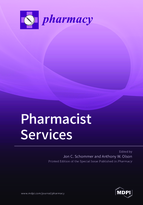Pharmacist Services
A special issue of Pharmacy (ISSN 2226-4787).
Deadline for manuscript submissions: closed (31 July 2019) | Viewed by 160657
Special Issue Editors
Interests: Information processing and decision making related to the provision, use, and evaluation of drug products and pharmacist services
Special Issues, Collections and Topics in MDPI journals
Interests: person-centeredness; community pharmacy; medication experience; pharmacy services; implementation science; community-integrated care
Special Issues, Collections and Topics in MDPI journals
Special Issue Information
Dear Colleagues,
We invite you to submit a manuscript to the “Pharmacist Services” Special Issue in the journal Pharmacy—an open access journal with a focus on pharmacy education and practice.
As an example, you may wish to take a look at previous special issues: https://www.mdpi.com/journal/pharmacy/special_issues
If the Special Issue publishes more than 10 papers, the publisher will print a book edition. The book would be made available, in digital format (for free) and paperback copies (ordered via Amazon) on the MDPI platform (http://books.mdpi.com).
Pharmacy (ISSN 2226-4787) is an international scientific open access journal on pharmacy education and practice published quarterly online by MDPI. The journal has already been indexed by PubMed, ESCI (Emerging Sources Citation Index), and Web of Science. Furthermore, Pharmacy is a member of the Committee on Publication Ethics (COPE), and, accordingly, submissions are peer reviewed rigorously to ensure that they conform to the highest standards in their field.
For the Special Issue on “Pharmacist Services” we seek a full breadth of manuscripts including, but not limited to the following topics: (1) the history and development of pharmacist services, (2) service settings, (3) service management, (4) service profitability, (5) service recovery, (6) service relationships, (7) service quality, (8) service tailoring, (9), service design and standards, (10) service performance, and (11) service evaluation. We seek manuscripts of all types including: (1) reviews, (2) commentaries, (3) idea papers, (4) case studies, (5) demonstration studies, and (6) research studies.
The overall goal of this Special Issue on “Pharmacist Services” is to give the reader a state-of-the-art synopsis of the pharmacist services domain at this point in time. To accomplish this goal, we seek papers that address the social, psychosocial, political, legal, historic, clinical, and economic factors that are associated with pharmacist services. Papers that translate concepts from other domains into the pharmacist services realm will be instructive to our audience and are welcome for this Special Issue.
Please note that we have framed this special issue using ideas published by renowned experts in the services management and marketing domains including: Teresa Swartz, Dawn Iacobucci, Roland Rust, Richard Oliver, Valerie Zeithaml, and Mary Jo Bitner. We will certainly consider papers that use other frameworks, but wanted to let you know about the foundational context that we will be using as we construct this Special Issue.
Thank you for considering this invitation.
Dr. Jon Schommer
Dr. Anthony Olson
Guest Editors
Manuscript Submission Information
Manuscripts should be submitted online at www.mdpi.com by registering and logging in to this website. Once you are registered, click here to go to the submission form. Manuscripts can be submitted until the deadline. All submissions that pass pre-check are peer-reviewed. Accepted papers will be published continuously in the journal (as soon as accepted) and will be listed together on the special issue website. Research articles, review articles as well as short communications are invited. For planned papers, a title and short abstract (about 100 words) can be sent to the Editorial Office for announcement on this website.
Submitted manuscripts should not have been published previously, nor be under consideration for publication elsewhere (except conference proceedings papers). All manuscripts are thoroughly refereed through a single-blind peer-review process. A guide for authors and other relevant information for submission of manuscripts is available on the Instructions for Authors page. Pharmacy is an international peer-reviewed open access semimonthly journal published by MDPI.
Please visit the Instructions for Authors page before submitting a manuscript. The Article Processing Charge (APC) for publication in this open access journal is 1800 CHF (Swiss Francs). Submitted papers should be well formatted and use good English. Authors may use MDPI's English editing service prior to publication or during author revisions.
Keywords
- Pharmacist Services
- Service Development and Implementation
- Service Quality
- Service Marketing and Management
- Service Evaluation







